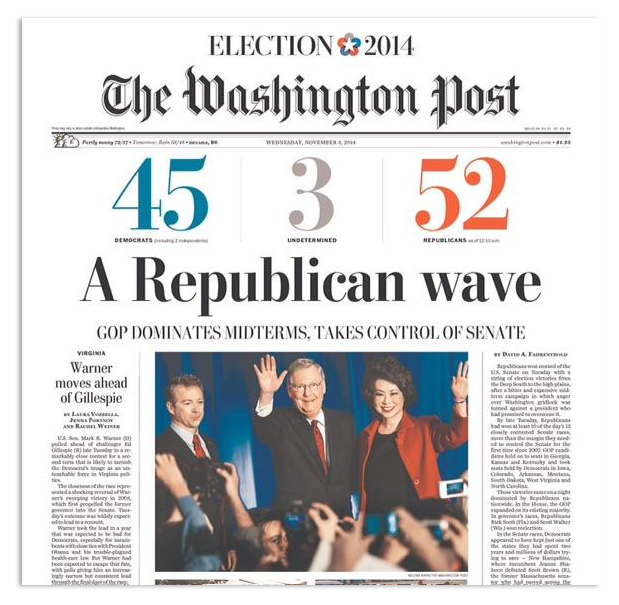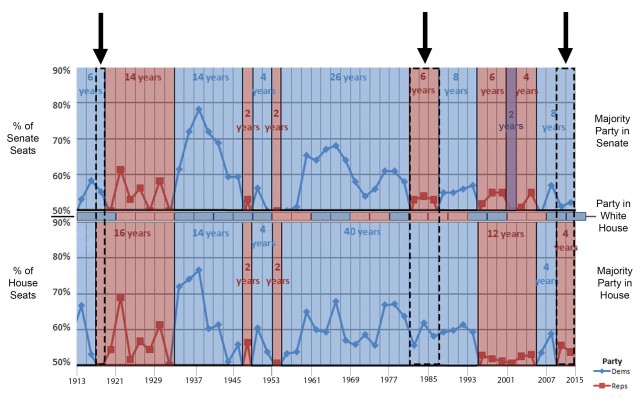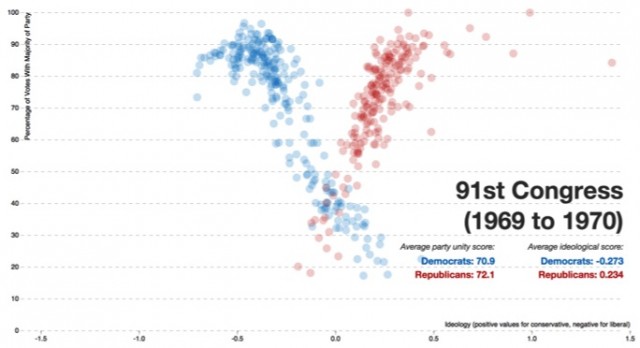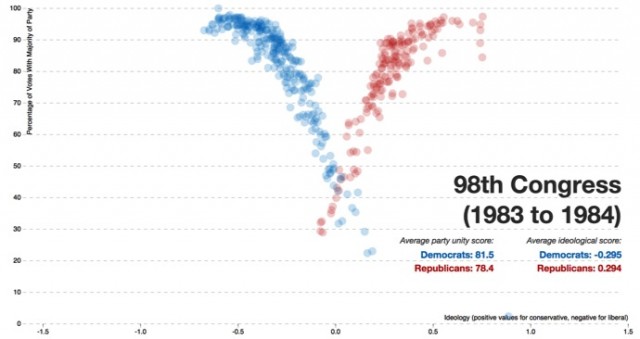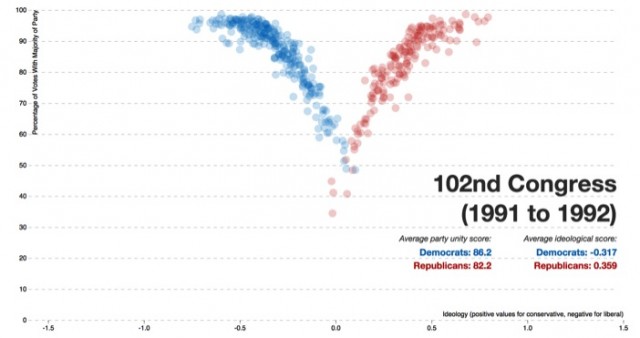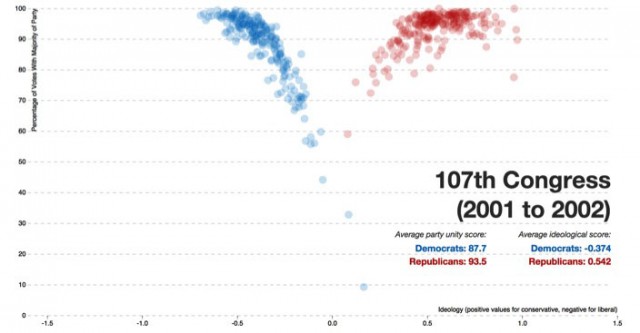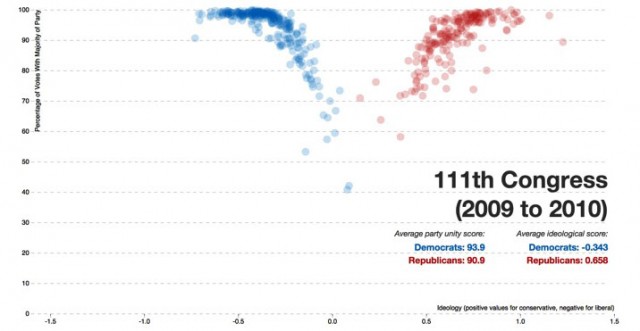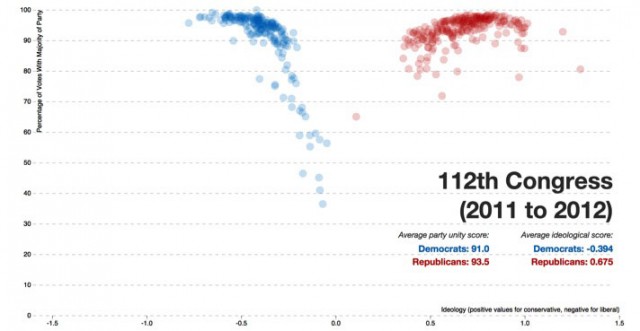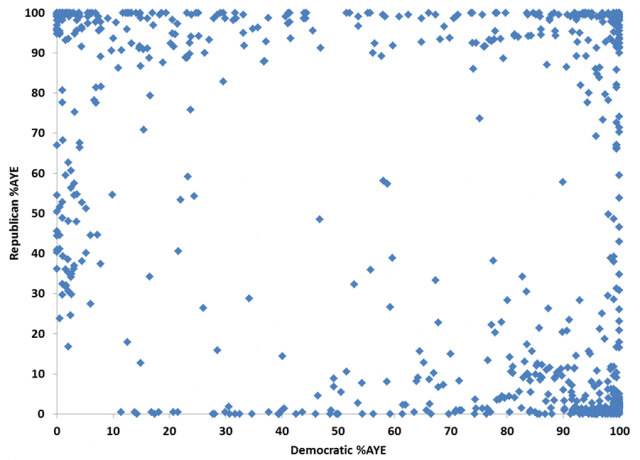In last week’s election, the Republicans won majority control of the Senate and further solidified their control of the House of Representatives. This means that the Republicans will lead the 114th Congress when it convenes next year.
Is this event positive for federal property investors? The answer is a resounding yes, but not necessarily for any ideological reason. It is simply that the Republicans’ victory reconciles a split Congress. In the last two Congresses (the 112th and 113th), the House was controlled by a Republican majority and the Senate controlled by a Democratic majority.
As we shall explore in this article, growing partisanship guarantees gridlock in our legislative branch unless both chambers of Congress are in alignment. This gridlock has had negative consequences for the government-leased property market, which should therefore benefit from last week’s election results.
Unified Control of Congress Matters
Split majority control of the two chambers is a rare but significant occurrence. In the past 100 years only three Presidents (Obama, Reagan and Wilson) have had to endure this split, as depicted in the chart below (clipped from Wikipedia and modified by me).*
Perhaps for this reason, Congress’s power and influence–and thus the perils of a divided Congress–are underappreciated. In the U.S. form of government, only Congress is authorized to write laws and to appropriate the budget, powers that have tremendous impact on nearly everything, including federal real estate.
As evidence that the split matters, the 111th Congress was the last unified Congress and it’s generally regarded as among the most productive in U.S. history. It was also among the most partisan–members of its House Democratic majority voted with their own party 94% of the time (with similar results in the Senate).
In the 112th Congress, the Republicans wrested majority control of the House but not the Senate, splitting party leadership of the two chambers. The split, compounded by the growing partisan divide, was enough to flip the switch from a hyper-productive legislature to the least productive (as measured by laws enacted) in U.S. history. The split continued into the current 113th Congress, which is on pace to edge out the prior session for the ignominious title of “least productive Congress ever”.
The Growing Partisan Divide
As noted above, the problems created by a split Congress are amplified by growing partisanship. Over the past half century, Democratic and Republican congressional members have grown a bit further apart ideologically but, more significantly, they’ve become much more partisan in their voting patterns, rarely breaking rank with their own party. With House and Senate control divided among the parties, increased partisanship has made a difficult situation much worse.
Thomas Mann and Raffaela Wakeman at the Brookings Institution put together a fascinating study of this emerging partisanship, including a series of scattergraphs that measure both ideology and the frequency with which Democratic and Republican members of the House of Representatives vote with their own parties. Their graphs plot the voting behavior of each member of the House of Representatives for each congressional term in U.S. history. Each Representative’s ideology is plotted on the horizontal axis (left side of the scale is more liberal and right side is more conservative). The frequency with which that person voted with the majority of his or her own party is plotted on the vertical axis. The selected graphs below demonstrate the House’s voting trend since the start of the Nixon Administration, almost a half century ago.
At the start of the Nixon administration, the House demonstrated ideological diversity and also less partisan voting than is evident among today’s lawmakers. For example, as shown on the horizontal axis, the voting records of some Democratic members of the House were more conservative than many members who identified with the Republican party. Most of these were Southern Democrats who not only voted conservatively but also showed a willingness to vote apart from the rest of their party.
By the second congressional term of Reagan’s presidency, some partisan separation had begun, though there were still Democratic and Republican Representatives who identified ideologically with the other party and who were willing to join in votes across the aisle. It is also interesting to note that Reagan’s was, until the Obama presidency, the last truly split Congress. The Republicans controlled the Senate but the Democrats (led by Speaker Tip O’Neil) held majority control of the House.
By the end of the George H.W. Bush presidency, Representatives routinely voted with their own parties, and the ideological gap between Republicans and Democrats had widened a bit further.
Both trends continued through the Clinton Administration to the start of the George W. Bush presidency, as shown below. By this point–both in reaction to the eight years under Clinton’s liberal leadership and the 9/11 terrorist attacks–the Republican party, in particular, had shifted further to the right, and Representatives on both sides of the aisle were voting almost exclusively along party lines.
By the start of the Obama presidency, the parties that comprised the 111th Congress were now fully separated ideologically. At least as evidenced by voting behavior, the most conservative Democrat was now more liberal than the most liberal Republican. Further, most Representatives were voting almost exclusively with their party majority. The Democrats controlled both chambers of this Congress and wielded that control to issue landmark legislation, including the $814 billion stimulus, the Affordable Care Act, climate change law, a slew of tougher regulations on Wall Street and also the creation of a consumer protection watchdog agency. The Republican opposition was effectively rebuffed in this most partisan Congress in U.S. history, with the Democrats victorious on partisan votes well more than 90% of the time in both the Senate and the House.
The 111th Congress is generally regarded as the most productive Congress since the era of LBJ’s Great Society so it is shocking that this uber-productive Congress would be followed by one that was, by most measures, including legislative output, the least productive in U.S. history.
In fact, as measured by party unity and ideology, the 112th Congress looked a lot like the 111th. So what caused the dramatic decline in productivity in a single term of Congress? The answer is simple: The 112th Congress was split. The Republicans had taken majority control of the House but the Democrats still controlled the Senate. That internal division, coupled with growing partisanship, resulted in gridlock.
Partisan Voting Trends
The real significance of the growing partisanship that is evident in the Brookings study charts is its effect on voting behavior. The graphs below (created by Gregory Koger, a professor at the University of Miami) illustrate in dramatic fashion the increase in partisan voting pattens. For each vote in the House of Representatives, Koger plotted the percentage of Republican and Democratic members who voted for the measure. In the Koger graphs, votes plotted in the upper right corner indicate consensus because the measures received an overwhelming majority of “ayes” from members of both parties. Clusters of votes in the upper left or lower right corners, however, indicate partisan voting behavior because those measures received an overwhelming number of “ayes” from one party with very little (if any) agreement from the opposing party.
For example, in the graph below, it is clear that there was no strong partisan voting behavior in the 95th Congress (convened at the start of the Carter Administration), but a significant number of measures received consensus support.
95th Congress (1977-1978):
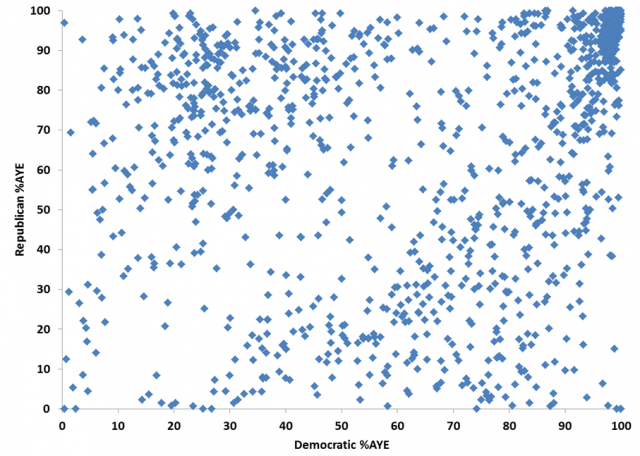
By the start of the Clinton Administration in 1993, partisan voting had become more common.
103rd Congress (1993-1994):
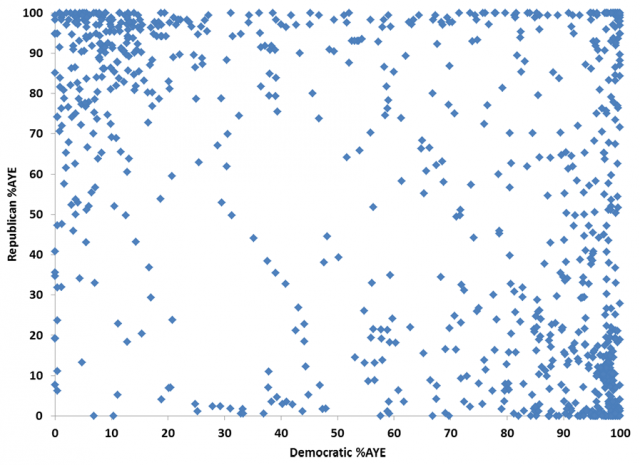
By the third and fourth years of the George W. Bush presidency, the partisan trend in the House had progressed even further with very tight clusters at the extreme corners of this graph.
108th Congress (2003-2004):
And, by the beginning of the Obama administration, in the 111th Congress, the hardening of partisan lines was essentially complete. Most votes were partisan, few votes achieved consensus and almost all votes attracted the near-complete support of one party or the other, drawing all voting behavior out to the edges of the scattergraph below.
111th Congress (2009-2010):
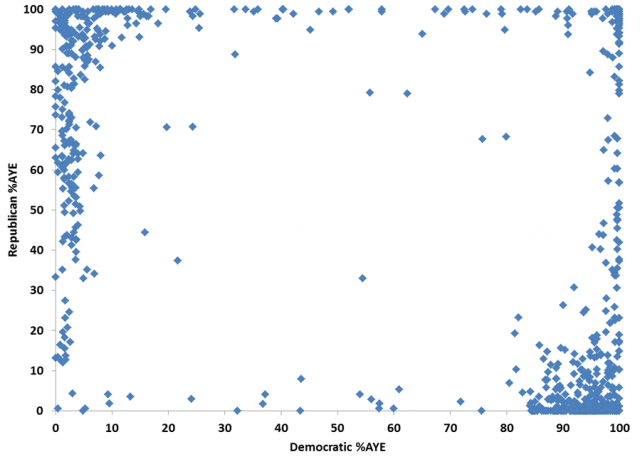
The following Congress, the 112th, had similar voting behavior in the House, and so will the current Congress, the 113th, once its record is tallied. Yet both the 112th and 113th Congresses were rendered largely ineffective by partisan gridlock between the House and Senate. With Republican control of the House and Democratic control of the Senate, legislation proffered by either chamber had no hope of passage through the other.
Does Gridlock Really Matter?
Do we really care if Congress is split and therefore gridlocked? Federal property investors certainly should. When the chambers of Congress are unable to agree and take action, the federal agencies are caught in the middle–they lack the budget clarity and confidence to engage in long-term planning. As a result, during recent split Congresses agencies have become reluctant to execute long-term leases. In the past few years, nearly half of GSA leases were for terms of three years or fewer as agencies kicked the can. This pattern is not welcome to property investors.
Much of the fundamental disagreement between Democrats and Republicans relates to the critical issues of federal spending and increasing national debt. The U.S. Debt Held by the Public now stands at almost $12.9 trillion the highest level since World War II. Despite a reduction in deficit to $483 billion (a substantial recovery from the 2009 through 2012 period when annual deficits exceeded $1 trillion) deficit spending is expected to continue to fuel the debt. The reason for this is that two-thirds of the federal budget funds mandatory spending, primarily comprised entitlement programs such as Medicare, Medicaid and Social Security, and, to a growing degree, interest on the national debt. Congress, therefore, only has appropriations control over one-third of the federal budget. No matter how hard Congress works to throttle back discretionary spending, its efforts are doomed to be overwhelmed by ever-growing mandatory spending.
Increasing spending and debt are structural issues that Congress can resolve only through some form of Grand Bargain that includes tax reform (to improve revenue) and/or entitlements reform (to reduce spending). This is why a functioning Congress is so important. Congress is the branch of our federal government that writes laws and authorizes and appropriates the budget. Only Congress can legislate to address these critical issues. Yet the split Congresses of recent years have been rendered completely incapable of action due to their internal conflict.
We do not expect partisanship to fade any time soon–it took a half-century for these party lines to harden. Yet, Congress has proven itself effective when both chambers are unified under one party. This is why the recent election results and unification of Congress under Republican control holds promise for federal property investors.
Of course, the outstanding question is whether the Republicans will use the next two years to implement tax and spending legislation that will ultimately create some headroom in the discretionary budget (which is where rent is paid), or whether they will simply use this time to posture for advantage in the 2016 presidential election. The answer will do much to shape the federal real estate market.
* At the start of George W. Bush’s first presidential term the Senate was split evenly. Eventually, Jim Jeffords (R-VT) changed his party affiliation to Independent and caucused with the Democrats, effectively giving them control of the Senate and splitting control of the two chambers of Congress. In any case, the 9/11 terrorist attacks occurred shortly thereafter, shaping the agenda and unifying that 107th Congress on most issues through the remainder of its term.

